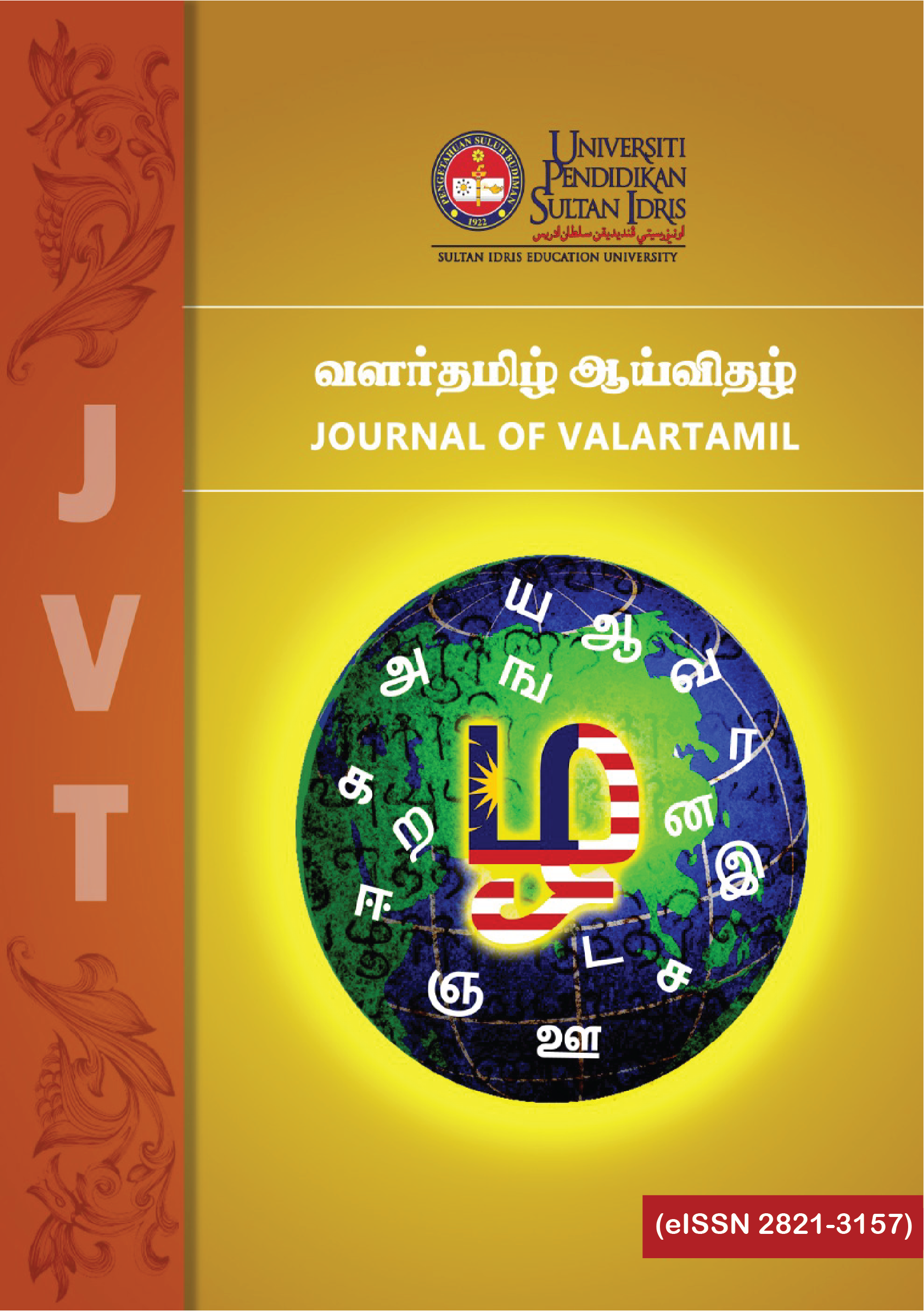கலித்தொகையில் பழந்தமிழரின் வாழ்வியல்
Lifestyle of Ancient People's in Kalithokai
DOI:
https://doi.org/10.37134/jvt.vol3.1.5.2022Keywords:
சங்க இலக்கியம், பண்பாடு, பழக்கவழக்கம், வாழ்வியல்முறைAbstract
தமிழ் மக்கள் தம்வாழ்வினை அகம், புறம் என இருவகையாகப் பாகுபடுத்தி அதன் கண்ணே நெறிப்படி வாழவும் தலைப்பட்டனர். இவற்றில் அகத்தில் தலைவன் தலைவியின் அன்பொழுக்கம், இல்லறமாண்பு, விருந்தோம்பல், பழக்கவழக்கம் போன்ற வாழ்வியல் கூறுகளைக் கலித்தொகைப் பாடல்களின் மூலம் ஆராய்வதே இக்கட்டுரையின் நோக்கமாக அமைகின்றது. தொகுக்கப்பட்ட தரவுகளின் அடிப்படையில் தரவுகளை வகைப்படுத்திப் பகுத்தலில் பகுப்புமுறைத் திறானாய்வும், அவற்றை விளக்குவதற்கு விளக்கமுறைத் திறனாய்வும் இவ்வாய்வில் அணுகுமுறைகளாகப் பயன்படுத்தப்பட்டுள்ளன. சங்க இலக்கியம் எனப்படுவது எட்டுத்தொகையும் பத்துப்பாட்டும் ஆகும். இந்நூல்கள் வாழ்வியல் அறத்தினை எடுத்தியம்புவதாக அமைந்துள்ளன. ஒழுக்க நெறியை நாம் கடைப்பிடிக்க நற்கருத்துகளைத் தன்னகத்தே கொண்டு விளங்குகின்றன. காலந்தோறும் மாற்றங்கள் நிகழ்ந்த வண்ணம் இருப்பினும், என்றும் நிலைத்து இருக்கக்கூடிய சங்க இலக்கியத்தில் சமுதாய மேன்மையையும் இன்றியமையாத தொன்மையுடைய வாழ்வியல் கூறுகளையும் காணமுடிகின்றது. ஒரு இனத்தின் தொன்மையையும், பெருமையையும், அவ்வினத்தின் வரலாற்றுச் சிறப்பினையும் அறிந்துகொள்ள வேண்டுமானால், அம்மக்கள் வாழ்ந்த இடம், பயன்படுத்திய மொழி, அவா்களின் கலை மற்றும் கலாச்சார பண்பாட்டுக் கூறுகள் போன்றவற்றின் வழியாகவே அறிந்து கொள்ள முடியும். இவ்வடிப்படையில் பார்த்தால், ஏறத்தாழ மூவாயிரமாண்டுகளுக்கு முன்பே சிறந்த நாகரிக வாழ்க்கை முறையைக் கடைப்பிடித்தவர்கள் தமிழர்கள் என்பது புலனாகும். அவ்வகையில் ‘கற்றறிந்தோர் ஏத்தும் கலி’, ‘கல்வி வலவர் கண்ட கலி’ என்று சிறப்பித்துக் கூறப்படும் கலித்தொகையில் பண்டைய தமிழரின் வாழ்வியல் சார்ந்த செய்திகள் ஆராயப்படவுள்ளன.The Tamil people divided their lives into two types of love life and chastity life and tried to live according to their respective norms. Among these, the purpose of this article is to explore the elements of life such as love, domestic respect, hospitality, and customs of the leader through the songs of the Kali. Based on the collected data, categorical analysis and descriptive analysis have been used as research approaches in this study. These texts are based on the virtue of life. In the Sangam literature, we find elements of the ancient life and essential social superiority, which, though changing from time to time, remain forever. If you want to know the antiquity, glory and historical features of a race, you can know it through the place where those people lived, the language they used, their art and cultural elements. Based on this, it can be known that Tamils had a highly civilized way of life three thousand years ago. Through this research paper, the aspects related to the life of ancient Tamils in Kalithokai are to be explored.
Keywords: Sangam Literature, Culture of Ancient People, Customs of Ancient People, Lifestyle of Sangam Ethnic Group
Downloads
References
Alagammai, K.P. (2001). Samuga Nokkil Sanga Mahalir, Chennai, Manivasagar Publication.
Arivuraj, N. (2008). Nattupurasamayam, Dindugal, Uma Publications.
Chandrasekaran, R. (2011.) Tamil Ilakkiyam: Vazhviyal Vizhumiyangal Panmuga Parvai, Coimbatore, Mahakavi Bharathiyar Noolagam.
Gandhi, K. (2003). Pazhanthamizhar PazhakkaVazhkkangalum Nambikkaikalum, Chennai, Ulaga Tamil Araichi Niruvanam.
Ilampuranar, (2008). Tholkappiyam Porulathikaram, Chennai, Sarada Publication.
Mathaiyan, P, (2001). Varalatru Nokkil Sanga Ilakkiya Pazhamarabu Kathaikalum Thonmangal, Thanjavur, Tamil University.
Puliyurkesikan, (2018). Silappathikaram, Chennai, Gowra Publications.
Rasamanikkam, K. (2006). Pandaiya tamizhar Vazhviyal, Selam, Tamilkudil, Publication.
Saivamum Vainavamum, (2003). Tamilnadu Government, Madurai, Arulmigu Meenakchi Sundareswarar Thirukoil.
Sanmugam Pillai, M. (1997). Sanga Thamizhar Vazhviyal, Chennai, Ulaga Tamil Araichi Niruvanam.
Sasi, S.S. (1990). Indiavil Aayar Samuthayam, Chennai, Institute of South Indian Stipees.
Sasivalli, (1985). Tamizhar Vazhviyal, Chennai, Ulaga Tamil Araichi Niruvanam.
Sivarajan, T. (1998). Sanga Ilakkiya Vazhviyal, Velur, Sivam Pathippagam.
Varatharasanar, M. (2004).Thirukkural, Chennai, Saiva Siddanandha Nool Pathippu Kazhakam.
Vengadasalam, R. (1957). Senthamizh Katturaikal, Thiruchi, Pazhaniyappa Brothers.
Viswanathan, A. (2007). Kalithogai, Chennai, New Cencury Book House.
Downloads
Published
Issue
Section
License
Copyright (c) 2022 Thangaraj Geethanjali

This work is licensed under a Creative Commons Attribution-NonCommercial-ShareAlike 4.0 International License.





